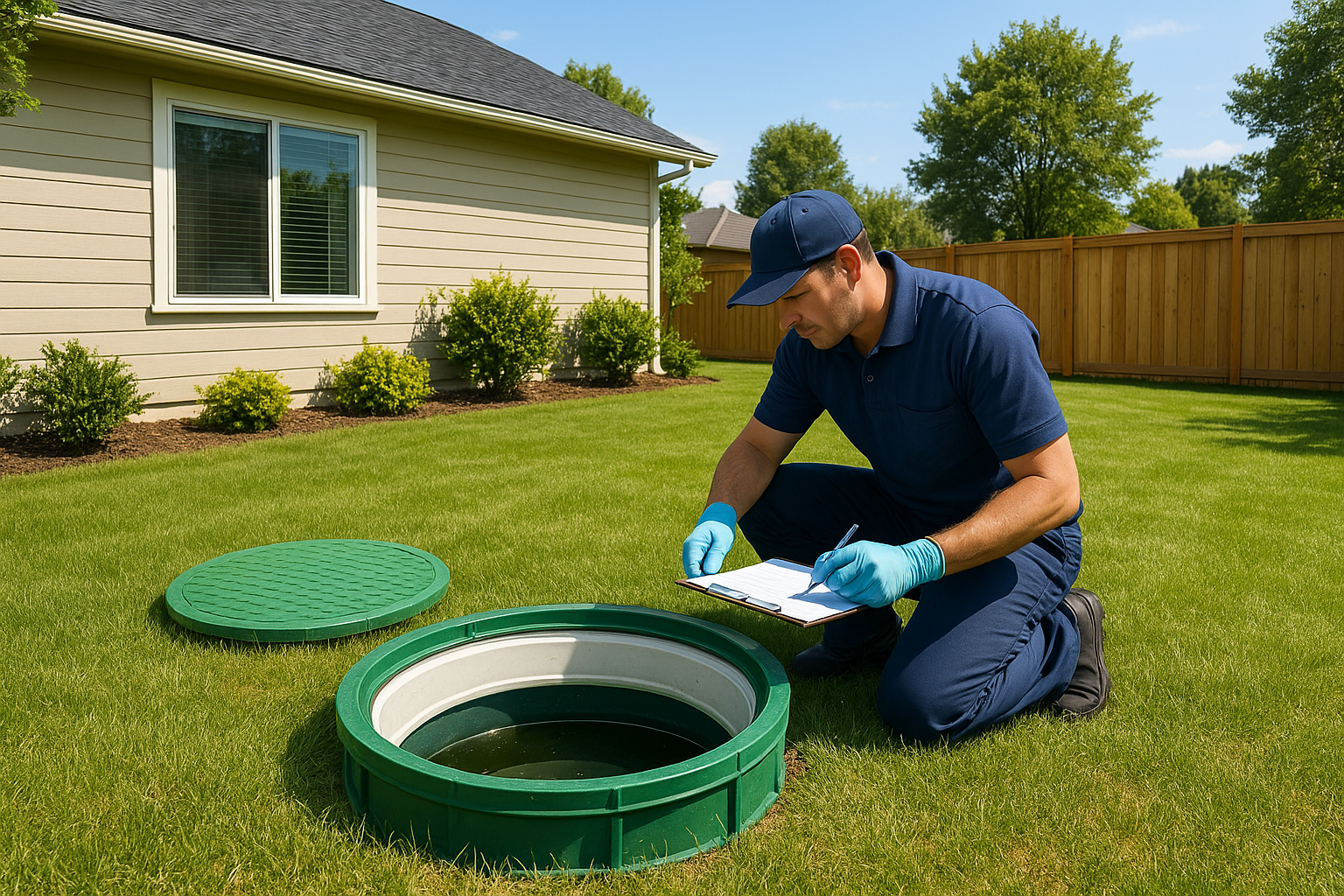Ever wonder what’s really going on beneath your yard when it comes to septic tank care? Many homeowners don’t think about it until something goes wrong—like slow drainage in sinks, sludge prevention failures in the tank, or an unpleasant odor creeping into the house. The good news is, with a little know-how, you can apply simple household wastewater tips that keep your septic system running smoothly without risking damage.
DIY septic care focuses on small but consistent steps you can handle yourself. These include drainfield upkeep, safe cleaning methods, and even regular effluent filter check tasks that prevent bigger issues. Grease disposal management, bacteria additives, and enzyme treatment solutions all play a role in keeping your system balanced and efficient. If you’re unsure whether these treatments are worth using, you can learn more in this guide on septic enzyme treatments.
A strong septic pumping schedule and awareness of low water usage tips also help extend septic system lifespan. When combined with backup prevention strategies and septic-friendly products, these steps protect not just your home, but also groundwater protection and the surrounding environment.
By the end of this guide, you’ll know what you can safely handle, which tasks require septic service providers, and how simple DIY routines reduce the risk of sewage overflow fix emergencies, costly septic replacement cost, or septic emergency repair calls.
Understanding Your Septic System: History, Basics, and Today’s Practices
Septic systems have been quietly managing rural property wastewater for more than a century. Originally designed as cesspools in the late 1800s, they evolved into modern septic system design setups that treat waste more effectively and reduce contamination. This long history highlights why septic tank care is more than a convenience—it’s essential for environmental and household safety.
At the core, a septic system consists of a tank and a backyard drainage system, often called a drainfield. Inside the tank, solids are separated from liquids, allowing safe filtration into the soil absorption field. When sludge prevention measures are ignored or maintenance frequency drops, the system struggles. Understanding how these pieces work together makes it easier to recognize when you need septic service providers or professional tank repair options.
Modern homeowners are now encouraged to use septic inspection checklist tools, schedule a septic pumping schedule, and apply bacteria additives to sustain natural balance. Greywater management practices, low water usage tips, and septic-friendly products reduce stress on the system while preventing costly septic replacement cost. For those working with limited yard space, a compact septic system can also be a practical alternative.
Smart technologies are also reshaping care, from effluent filter check tools to septic treatment tablets and monitoring devices that detect problems early. Still, no matter how advanced the system becomes, septic warranty plans and professional inspections remain essential.
Key Components of DIY Septic System Maintenance
DIY septic system care centers around proactive measures. While not everything can be handled without professionals, many tasks fall safely into a homeowner’s routine. These actions improve household plumbing health and protect groundwater protection while extending system lifespan.
- Regular Inspections – Follow a septic inspection checklist to spot leaks, backups, sewage overflow fix signs, or unusual odors. Consistent checks help with early problem detection and backup prevention.
- Waste Management Awareness – Avoid grease disposal and harsh chemicals. Stick with biodegradable cleaners to support natural breakdown.
- Water Usage Practices – Conserve with low water usage tips such as spreading laundry loads across several days or fixing leaks quickly. Pair these with rural sanitation tips for added efficiency.
- Additives and Treatments – Support the tank with safe bacteria additives or eco-friendly septic design practices. Enzyme treatment enhances natural decomposition.
- Surface Protection – Keep the drainfield clear of heavy machinery or landscaping that risks root intrusion. Leach field restoration is much costlier than prevention.
For example, if a homeowner uses septic treatment tablets monthly, solids decompose faster, reducing sludge prevention concerns. Likewise, paying attention to tank cover safety and avoiding non-biodegradable waste keeps the system healthier.
When combined, these practices create a strong foundation of maintenance frequency that avoids costly septic replacement cost or septic emergency repair events.
Benefits of Proactive DIY Septic Maintenance
Taking proactive control of septic system lifespan through DIY care offers homeowners both financial and environmental advantages. Small actions such as bacteria additives, eco septic solutions, or septic-friendly products make a big impact without requiring advanced knowledge.
Key benefits include:
- Cost Savings – Staying on top of sludge prevention and backup prevention reduces septic replacement cost.
- Extended Lifespan – Effluent filter check tasks and water conservation extend tank and drainfield health.
- Environmental Protection – Proper grease disposal and adherence to sewage disposal laws protect groundwater protection and local ecosystems.
- Early Detection – Regular septic pumping schedule reminders and septic inspection checklist use detect issues before septic emergency repair becomes necessary.
- Peace of Mind – Knowing the system is protected and functioning keeps household plumbing health steady.
For example, one homeowner uses low water usage tips and eco septic solutions regularly, delaying tank repair options by years. Another family, monitoring their septic pumping schedule closely, prevents costly sewage overflow fix and avoids local contamination issues.
In addition, the right septic deodorizers can help reduce odors naturally while supporting tank balance, adding comfort to your proactive care.
Challenges and Considerations in DIY Septic System Maintenance
Even with great household wastewater tips, DIY septic care isn’t without limitations. Some tasks, like deep tank repair options or sewage overflow fix projects, require septic service providers with specialized tools.
Common challenges include:
- Limited Access – Tank installation guide tasks like accessing underground pipes often need professional support.
- Mistakes – Using incorrect products or skipping septic pumping schedule checks causes system damage.
- Knowledge Gaps – Lack of awareness about septic system design or sewage disposal laws creates risks.
- Physical Labor – Moving tank lids or tackling leach field restoration can be unsafe.
Strategies to navigate challenges include:
- Stick to safe cleaning methods, bacteria additives, and septic treatment tablets.
- Take a septic certification course to better understand septic-friendly products and septic warranty plans.
- Use eco septic solutions and biodegradable cleaners whenever possible.
- Keep septic emergency repair contacts available for sudden issues.
Rental property owners, in particular, should follow dedicated septic care tips to handle higher usage and reduce risks.
Practical DIY Steps You Can Start Today
To maintain septic system lifespan and prevent septic replacement cost, apply a structured approach:
- Inspect Regularly – Look for leaks, odors, or pooling water in the backyard drainage system.
- Track Household Plumbing Health – Fix leaks, conserve water, and apply low water usage tips.
- Manage Waste Responsibly – Avoid grease disposal and switch to biodegradable cleaners.
- Use Treatments Safely – Apply enzyme treatment or septic enzyme treatments as needed.
- Protect the Area – Maintain tank cover safety, prevent root intrusion, and support soil absorption.
- Schedule Pro Support – Even with DIY care, have septic service providers inspect every 2–3 years.
Helpful tools include septic inspection checklist kits, water monitors for greywater management, and septic warranty plans for added protection. Combining DIY with rural sanitation tips ensures long-term performance.
The Future of Septic System Care: Trends and Innovations
Septic system design continues to evolve, with innovations enhancing both efficiency and eco-friendliness. Emerging trends include:
- Smart Monitoring Systems – Sensors for septic pumping schedule tracking and tank repair options prediction.
- Eco Septic Solutions – Biodegradable cleaners, enzyme treatment, and eco-friendly septic design.
- Advanced Drainfield Upkeep – Materials supporting leach field restoration and soil absorption efficiency.
- Water Conservation Integration – Wider adoption of greywater management and low water usage tips.
Impacts include reduced septic replacement cost, stronger septic warranty plans, and better compliance with sewage disposal laws. Septic service providers will see growth in eco septic solutions and septic certification course offerings.
For homeowners, these trends mean fewer septic emergency repair calls, extended septic system lifespan, and improved groundwater protection. Communities benefit from stronger rural sanitation tips and healthier ecosystems.
Taking Control of Your Septic System: Key Lessons and Next Steps
By now, you’ve learned the essentials of septic tank care, septic pumping schedule practices, and backup prevention strategies. Here’s what to keep in mind:
- Proactive Care Saves Costs – Monitoring maintenance frequency prevents sewage overflow fix emergencies and septic replacement cost.
- DIY Complements Professionals – Household wastewater tips help, but septic service providers remain vital.
- Consistency Is Key – Using septic-friendly products, eco septic solutions, and bacteria additives ensures septic system lifespan.
Maintaining septic systems is more than a task—it’s an investment in household plumbing health, groundwater protection, and long-term peace of mind.
Start small: follow your septic inspection checklist, apply enzyme treatment monthly, or review septic warranty plans. With these steps, you prevent septic emergency repair calls and keep your rural property wastewater system dependable for decades.






